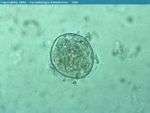Difference between revisions of "Protozoa Life Cycle"
Jump to navigation
Jump to search
m (Added link to toxoplasma gondii) |
|||
| (5 intermediate revisions by 3 users not shown) | |||
| Line 17: | Line 17: | ||
*Facultatively heteroxenous | *Facultatively heteroxenous | ||
**Parasite '''may''' use more than one host during its life cycle but this is not essential | **Parasite '''may''' use more than one host during its life cycle but this is not essential | ||
| − | **E.g. '' | + | **E.g. ''Toxoplasma gondii'' |
===Example of a Protozoal Life Cycle=== | ===Example of a Protozoal Life Cycle=== | ||
| − | See [[Coccidia | + | See [[Coccidia]][[Category:Protozoa]] |
| − | |||
| − | |||
| − | |||
| − | |||
| − | |||
| − | [[Category:Protozoa | ||
| − | |||
Revision as of 19:04, 18 May 2010
Protozoa multiply sexually, asexually and can also use a combination of both, as seen in the coccidia class. Replication can be by binary or multiple fission. Different protozoa use different forms of motility, including flagella, cilia, pseudopodia and gliding.
- Most protozoal reproduction is asexual via binary fission, schizogony and sporogony
- Some protozoa also use sexual reproduction called gametogony
- In some species, sexual and asexual reproduction occurs in the same host, whilst in others asexual reproduction occurs in the vertebrate host and sexual reproduction in the arthropod vector
- Homoxenous
- Parasite uses a single host species during its life cycle (direct)
- E.g. Eimeria
- Heteroxenous
- Parasite uses more than one host during its life cycle (indirect)
- E.g. Trypanosomes
- Facultatively heteroxenous
- Parasite may use more than one host during its life cycle but this is not essential
- E.g. Toxoplasma gondii
Example of a Protozoal Life Cycle
See Coccidia
